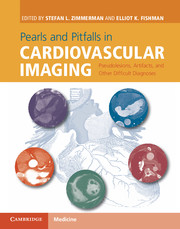 Pearls and Pitfalls in Cardiovascular Imaging
Pearls and Pitfalls in Cardiovascular Imaging from Section 1 - Cardiac pseudotumors and other challenging diagnoses
Published online by Cambridge University Press: 05 June 2015
Imaging description
Within the pericardial cavity, there are several recesses and sinuses where fluid can collect in close contiguity to the major vessels and lymph nodes, and can be misinterpreted as lymphadenopathy or mediastinal mass. The posterior portion of the superior aortic recess lies directly posterior to the ascending aorta, and is seen as a well-defined crescentic fluid collection on CT (Figure 7.1). The superior aortic recess is usually caudal to the aortic arch, but some- times extends cephalad and rightward into the right paratracheal region between the brachiocephalic vessels and the trachea (Figure 7.2), even in patients without pericardial effusion. This is called the “high-riding” superior pericardial recess and may mimic hypodense paratracheal lymphadenopathy or a cystic mediastinal mass. Fluid accumulation within the pericardial “sleeve” recess adjacent to the right inferior pulmonary vein can also mimic adenopathy (Figure 7.3).
Importance
With recent technological advances that provide high temporal and spatial resolution there has been improved visualization of fine anatomic details of the pericardium, resulting in the routine visualization of the pericardial recesses. A pericardial recess with prominent fluid may simulate hypodense lymphadenopathy or a cystic mass, especially in the setting of known primary malignancy.
Typical clinical scenario
A pericardial recess is typically incidentally found on chest CT imaging. The pericardial cavity is a potential space between the parietal and visceral layers of the serous pericardium. It normally contains a small amount of serous fluid (15–25ml). The superior aortic recess is the upward extension of the transverse sinus of the pericardial cavity, and seen in 47% of patients without known pericardial disease. The superior pericardial recess is the posterior division of the superior aortic recess, and is usually seen just caudal to the aortic arch. However, it may extend more superiorly in the right paratracheal region, and may mimic a paratracheal lymph node or cystic mass. A highriding superior pericardial recess was diagnosed in 6 (2%) of 276 patients in a study by Choi et al.
To save this book to your Kindle, first ensure [email protected] is added to your Approved Personal Document E-mail List under your Personal Document Settings on the Manage Your Content and Devices page of your Amazon account. Then enter the ‘name’ part of your Kindle email address below. Find out more about saving to your Kindle.
Note you can select to save to either the @free.kindle.com or @kindle.com variations. ‘@free.kindle.com’ emails are free but can only be saved to your device when it is connected to wi-fi. ‘@kindle.com’ emails can be delivered even when you are not connected to wi-fi, but note that service fees apply.
Find out more about the Kindle Personal Document Service.
To save content items to your account, please confirm that you agree to abide by our usage policies. If this is the first time you use this feature, you will be asked to authorise Cambridge Core to connect with your account. Find out more about saving content to Dropbox.
To save content items to your account, please confirm that you agree to abide by our usage policies. If this is the first time you use this feature, you will be asked to authorise Cambridge Core to connect with your account. Find out more about saving content to Google Drive.